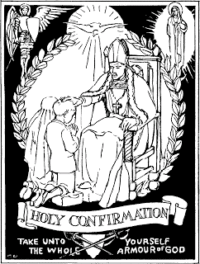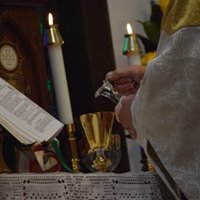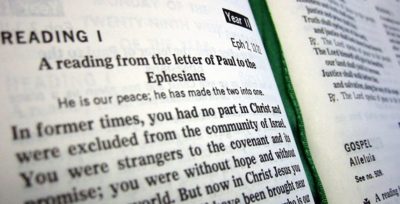Heresies, Ecumenical Councils, Word and Sacrament, English Bible

CHAPTER 6
Heresies and False doctrines arose. Heresies are nothing new…as False doctrines arose;
In the days of the Apostles. Brief description of:
- Legalism (Galatians)
There were those teaching that you had to be “Jewish” before you could become a Christian and thus the Laws of the Temple applied (not the laws of God – the Ten Commandments.)
- Asceticism (Colossians)
There were those who were teaching a exercise or training which went beyond the teachings of Christ. Some of the ascetic practices included a renunciation of marriage, home, and property. As well there were extreme forms of fasting and self- deprivation. Of note see Articles of Religion: XIV Of works of Supererogation: XIV. Of Works of Supererogation: “Voluntary Works besides, over and above, God’s Commandments, which they call Works of Supererogation, cannot be taught without arrogancy and impiety: for by them men do declare, that they do not only render unto God as much as they are bound to do, but that they do more for his sake, than of bounden duty is required: whereas Christ saith plainly When ye have done all that are commanded to you, say, We are unprofitable servants.”
- Docetism (I John)
A tendency evolved which considered the humanity and sufferings of the earthly Christ as apparent rather than real. They were teaching that Christ had miraculously escaped the pain of death.
LATER Heresies…
Gnosticism, Montanism, and Marcionism.
Gnosticisim:
Hellienistic with some Christian ideas – goal was to make universal religion based on the Greek Word Nois – meaning knowledge. Based upon a Supreme Being (The Abyss) which was unapproachable – we cannot define it because “matter” has nothing to do with the Abyss. This Abyss sent forth lesser deities’ which have some divine attributes but with each generation the attributes are less. The Kenoma is the material world (darkness) and the Pleroma is the heavenly realm. The creator God is the Demiurge and Christ was not incarnate. The Gnostics were trying to reconcile evil and good (a main point of Greek writings) – how could evil come from a “good” God. This dividing up of a higher God (Abyss) and lower God (Demiurge – Creator God) which flows from the Pleroma was a way to explain where this evil came from. Through this “gnosis” knowledge was revealed, to some men in which had entered a seed or spark of Divine spiritual substance, this special knowledge of God. Through this “gnosis” one might be rescued from its evil material environment and assured of a return home in the Divine Being. The function of Christ was to come as the emissary of the supreme God bringing “gnosis.”
Montanism:
An apocalyptic movement (the End is near / here) in the latter half of the 2nd century. It lived in expectation of the speedy outpouring of the Holy Spirit (the Paraclete) on the Church, of which it saw the first manifestation in its own prophets (Montanus) and prophetesses (Priscilla and Maximiila.) They proclaimed that the Heavenly Jerusalem would soon descend near Pepuza in Phrygia. This movement developed ascetic traits (condemned existing regulations on fasting as being too lax) forbidding second marriages, imposing a strict discipline of its own. Montanus would lose conscience when proclaiming the truth of God – in a state of ecstatic prophecy as he became a mouth piece of God (the orthodox said he was demon possessed as his eyes would roll back in head as he proclaimed Gods words.) Montanism believed in the deity of Christ and believed that the OT gave dispensation of Father, and the NT of the Son and was the unfolding of the Spirit (Tertullian followed later in his life.)
Marcionism:
A very popular heresy founded by Marcion (son of a Bishop- excommunicated by his father who then went to Rome and was excommunicated again – so he founded his own church.) Like the gnostics – a dualism of a Demiurge God (who was harsh and wicked through whom evil entered into world.) Main thrust was that the Christian Gospel was wholly a Gospel of Love to the absolute exclusion of Law. This doctrine led him to reject the OT completely. The Demiurge was wholly a God of Law and it had nothing in common with the God of Jesus Christ. Thus it was Jesus purpose to overthrow the Demiurge.
Age of the Christian Roman Empire
The Council of Nicaea, its major parties, individuals, decisions, and its relevance to modern day Christianity?
When Constantine defeated Emperor Licinius in 323 AD he ended the persecutions against the Christian church. Shortly afterwards Christians faced a trouble from within: the Arian controversy began and threatened to divide the church. The problem began in Alexandria, it started as a debate between the bishop Alexander and the presbyter Arius. Arius proposed that if the Father begat the Son, the latter must have had a beginning, that there was a time when he was not.
The Council of Nicaea, a gathering similar to the one described in Acts 15:4-22, condemned the beliefs of Arius and wrote the first version of the now famous creed proclaiming that the Son was “one in being with the Father” by use of the Greek word “homoousius.” The Council of Nicaea (325) was convened as some three hundred bishops gathered from all around the world. The bishops of the Council stopped their ears on hearing the words of Arius and immediately rejected his teaching as distant and alien from the belief of the Church. They tore to pieces a letter of Eusebius of Nicomedia containing Arius’ teaching, as well as an Arian confession of faith. Originally seventeen of those bishops gathered at the council were unwilling to sign the Creed penned by the Council, and all but three of these were convinced to sign by the end. It is thus apparent that the Arians were a distinct minority among the bishops. The impact upon the Church was and is dramatic as it is the one of the legs upon which the doctrine of the Trinity stands and is the foundation of Christian thought throughout the world.
Synopsis of the following Ecumenical Councils:
- Council of Constantinople, A.D. 381
Condemned Macedonian and other heresies and reaffirmed the Creed. It was held to unite the Eastern Church at the end of the lengthy Arian controversy on the basis of the Nicene faith. Its achievement was sufficiently significant for it to be regarded as the “Second General Council in both East and West.
- Council of Ephesus, A.D. 431
Third General Council which was held in hope of settling the Nestorian controversy – its rejection of Nestorianism the council gave the formal approval of the title Theotokos (“one who gave birth – title to the Blessed Virgin Mary.)
- Council of Chalcedon, A.D. 451
Hypostatic Union of Christ – two natures / one person. It reaffirmed the definitions of Nicaea and Constantinople as sufficient account of the orthodox faith about the person of Christ and that the errors of Nestorius (two persons – divine and human – in one Christ) and Eutyches (denying Christ manhood was consubstantial with ours which is incompatible with redemption through Him) be repudiated.
- Council of Constantinople, A.D. 553
Fifth General Council condemned the survival of heresies previously mentioned and the “Three Chapters” which were all considered sympathetic to Nestorius and its authors were anathematized and no cannons were issued.
- Council of Constantinople, A.D. 680-681
The sixth General Council met over their concern with Monotheism (two natures but one will – of Christ) and condemned Macarius, the Patriarch of Antioch. The decree coming from the council was a reproduction of the profession of faith drawn up at Chalcedon.
- Council of Nicaea, A.D. 787
The Seventh General Council was convened to resolve the Iconoclastic controversy which declared all images as idols, thus proclaiming they were all to be destroyed. The council declared the veneration is a matter of respect and honor.
What do the Ecumenical Councils have to do with Anglican theology?
Ecumenical Councils relate to Anglican theology as the ecumenical Councils which excludes councils since the schism between the Eastern and Western Church with the last council being the second of Nicaea in 787. Article 21 of the Thirty Nine Articles, states that the council “may err, and sometimes have erred, even in things pertaining unto God”, and that what they ordain is to be tested by reference to Scripture. As well the Reformation Legum Ecclesiasticarum (1553) states that General Councils are regarded with honour and that the decisions of the first Four in particular are “accepted and received with great reverence.”
The Medieval Church
The Church Fathers were educated teachers who read Scripture within the world of Hellenistic intellectual circles (Greek language and culture) in the Roman Empire dominated by a new understanding of Plato. In these intellectual circles in Alexandria and Rome, the universe from top to bottom, from God to matter, is a unified whole. Everything in the universe finds its fulfillment in communion with God, and everything in the universe is striving toward communion with God. This reading of nature was extended to the reading of texts as material and verbal signs that communicate and mediate this divine reality. For these readers, the text had two levels of meaning. The literal sense described the events, with all the moral and intellectual dilemmas they present. The spiritual sense described the divine truth that they disclosed. Every text of Scripture was read in the light of the movement of the universe from bondage toward communion with God, now understood in terms of the crucified, resurrected, and exalted incarnation of God, Jesus Christ.
The Medieval Church intentionally preserved this repository of faith from the early Church, and read Scripture in dialogue with these traditional readings. Their literary readings substantially elaborated the “spiritual” readings from the earlier period. In a literal reading of the Exodus, the ancient Israelites left the land of Egypt in the time of Moses. In an allegorical reading, it refers to the redemption done by Christ. In a moral reading, it refers to the conversion of the soul from sin to grace. In an ultimate reading (anagogic), it refers to the final liberation of the soul from corruption to glory. This rich elaboration of the spiritual meaning of the text never displaced the literal (or historical) reading of the text, with all its untamed meanings and implications.
In many ways, Thomas Aquinas is the culmination of this tradition. He carried forward this tradition in the language of Aristotle, which provided a constructive emphasis on the material universe, drawn irresistibly toward God, the unmoved mover. This language also allowed a constructive dialogue with the scientific understanding of the natural world. Aquinas’ reading of Scripture had a corresponding emphasis on the literal meaning, with all its ambiguities and limitations—and all its qualifications of the carefully wrought spiritual meanings. In particular, Aquinas’ reading of Scripture was at its root an encounter with the living God that underlies and transcends all these words and texts, and not a pure exercise in textual authority.
The Reformers
The Protestant Reformation of the sixteenth century was, at one level, a reaction to the accommodation of the Church to the power and policies of the various European states, and the power and privilege that the Church shared with the rulers of these states. The gospel of the reformers in Germany and Switzerland was dominated by the Pauline proclamation of the grace of God. The grace of God is the beginning and the presupposition of our life in the presence of God, not the result of a life of virtue and piety (i.e.we are “justified by grace through faith.”) This proclamation of grace is entrusted to the Church, but it is not the property of the Church. Scripture is fundamentally a witness to the mystery of the grace of God, not a founding text for the prevailing political order undergirded by official doctrine.
The mystery of the living God and the reality of the grace of God transcend the prevailing order and transform our understanding of the words in the text of Scripture. For Martin Luther, the word of God is “in-lettered” in the human voices we hear in Scripture, as God is incarnate in the human being Jesus Christ. For John Calvin, the words of Scripture are “mean and lowly words,” the rhetorical accommodation of the divine word to the capacities of its human hearers. In their interpretation of Scripture, the reformers worked from the historical meaning of the text, rather than the traditional body of spiritual readings from the fathers and doctors of the Church. The emphasis on “scripture alone” was a rejection of the authority of this repository of faith Under the rubric of “scripture interpreting scripture,” the reformers made the mystery of divine grace and its capacity to transform human life the central principle of interpretation.
The reformer’s emphasis on “scripture alone” never displaced their profound awareness of their confessional model for interpretation and of their own finitude as interpreters of the word.
The Anglicans (Word and Sacrament):
From the beginning of the Anglican tradition, the reading and hearing of Scripture has been integrally connected with our worship—”the rule of prayer is the rule of faith.” In a portent of the reformation of the Church of England, the Scripture lections in the Latin mass were read in English. For Richard Hooker, who articulated the spirit of the new Anglican tradition, the “medicine of grace” that comes through Jesus Christ is communicated in the Word and in the Eucharist. This is the context in which Scripture is read and interpreted. This emphasis on the grace of God in the life of the Church lay behind a tendency to avoid narrow definitions and overly precise formulations that created needless divisions. This tendency was dramatically expressed in the approach to Scripture in the official English translations. In our reading of Scripture, as in our common prayer and worship, we are brought into the presence of a God who calls us into communion.
An example of interpreting Scripture (…my thesis at RTS)
A review of this work (the King James Bible) gives a great insight into the life and ministry of Lancelot Andrewes, one of main editors of KJB 1611, as it seems that “words” are never enough when it comes to God. God was personal to Andrewes and even with his great skill and knowledge he had to go beyond words, as observed in his prayer life and his liturgical practice. God is so great, that even when using all skills and senses they fail to fully describe and reveal God. There is always a mystery of God which is beyond our ability to understand. Anselm decades earlier had tried to describe God (the ontological debate), but Andrewes would always strive to make God as personal as possible in his sermons, prayer life, and liturgy as a way of encouraging people to come to Him. He believed that only through our humbleness and acknowledgment of our unworthiness could we approach God. His work on the King James Bible is a great example of making God a personal living God. Of Andrewes’ importance, Nicolson states that the case can be made that Andrewes as Chairman, if there was a translator of the first books of the King James Bible, it was Andrewes.[1]
Genesis Translation Comparisons
The validation of the previous begins with Gn 1:1. By examining the work of the Protestant martyr, William Tyndale’s translation of the 1530’s, one can move on to the improvements seen in the upgrade made during the 1550’s in the Geneva Bible, and then finally the finished work of the King James Bible in 1611 concludes the comparisons. The following account goes verse by verse, beginning with Tyndale’s translation:
“In the beginnyng God created heauen and erth. The erth was voyde and emptye, and darcknesse was vpon the depe, & the spirite of God moued vpon the water.” While this description of void, dark, and deep is clarifying and useful, it is less interested in ‘the grandeur of its music than the light it brings.’[2] (sort of “just the facts)
Progressing next to the Geneva Bible is translated: “In the beginning God created the heauen and the earth. And the earth was without form and void, and darknesse was upon the deep, and the Spirit of God moved upon the waters.” In the Geneva Bible Tyndale’s basic wording was taken and made something more fluent, as by describing “voyde” as something “without form” and “emptye” as being “void,” of which both try to better describe something that is almost impossible to understand; as something from “nothingness” is attempted to be described.
Andrewes’ group would take the qualities listed above and paint an almost artistic description: In the beginning God created the Heauen, and the Earth. And the earth was without forme, and voyd, and darknesse was vpon the face of the deepe: and the Spirit of God mooued vpon the face of the waters. Nicholson explains these changes as he says:
These are slight and marvelous changes. Some are almost purely rhythmic. To say ‘the Heaven’ and ‘the Earth’, which he borrowed from the Genevans, allows an easier run than Tyndale’s harsher and more naked substantives. The commas after ‘Heauen’ and in the second verse are signs to pause in the reading of it, and the colon after ‘deep’ marks a slightly longer rest. In the slightest of ways, Andrewes introduces two new qualities to add to Tyndale’s: an aural fluency and the sense of ease which comes from that; and, allied to that ease, a pace of deliberate and magisterial slowness, no hurry here, pausing in its hugeness, those bass colors in the vocabulary matched by a heavy, soft drumming of the rhythm. It is as solemn and orderly as the beginning of a steady and majestic march.[3]
The “face” upon the deep and upon the water is used twice by Andrewes. Why not use “surface?” Here is where simple words, one could say even words themselves, seemed not enough for Andrewes. Why choose “face” and not a word like “surface” or some other technical word?
To Andrewes God is a living God, not some technical abstract being, as Nicholson explains: instead, ‘face’ has a rich, plain Englishness to it, and in using it Andrewes is more accurate than Tyndale (as is ‘waters’ in the plural). But it is also, in its physicality, more stirring. The spirit of God moving on the face of the waters has a mysterious and ghostly humanity to it which neither the modern translations nor Tyndale’s blankness can match. The face of the waters carries a subliminal suggestion that the face of God is reflected in them. That too is a baroque suggestion, a scene from Michelangelo or Blake. In this first, archaic darkness a connection already exist between God and his creation. The universe from the moment of its making is human and divine, almost as if, purely by this one lexical gesture, James’s Translators are foreshadowing the whole long story which will unfold from that first moment.[4]
This closeness to God, this personal God, this God who creates and gives, this same God that demands and judges, is the God which Andrewes, even with his gifts of words and languages, seems to ever strive to be near. With words inadequate to fully explain, and our humanity unable to obey, Andrewes throughout his life would not only use words, but all senses to describe and communicate with God. A hunger to please God pushes him into an ascetic lifestyle[5] within a renaissance world full of new ideas and new ways of thought, action, and lifestyle. Being of a Creator God, within a creation which seems never satisfied with God’s revelation, is the world of today as it was in the world of Andrewes.
[1] Adam Nicolson, God’s Secretaries The Making of the King James Bible, (New York: Harper Collins Publishers, 2003), 192.
[2] Ibid., 192-3. Gen 1:1 “In the begynnynge God created heaven and erth.” Gen 1:2 “The erth was voyde and emptie ad darcknesse was vpon the depe and the spirite of god moved vpon the water.”
[5] H.R. McAdoo, The Structure of Caroline Moral Theology, (New York: Longmans, Green and Co., 1949), 168. Of referring to Andrewes work A Pattern of Catechistical Doctrine McAdoo refers to his work as moving him towards a moral and ascetic theology.



![How did the early Christians worship? Let’s us read of early church worship. The First Apology (St. Justin Martyr) [a.d. 110-165.]](https://www.stmichaelsanglican.org/wp-content/uploads/2018/04/church-history1-e1562081769989.jpg)
